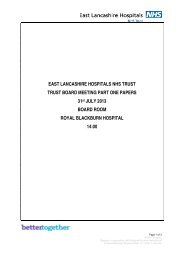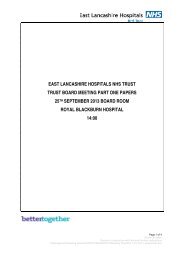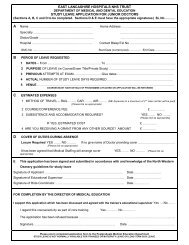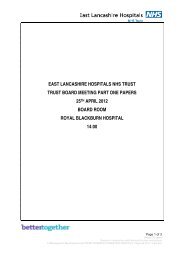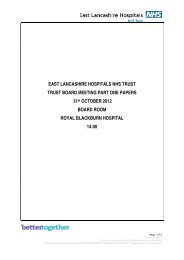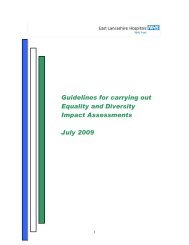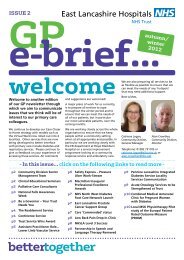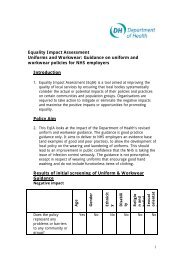Equality Impact Assessment template
Equality Impact Assessment template
Equality Impact Assessment template
You also want an ePaper? Increase the reach of your titles
YUMPU automatically turns print PDFs into web optimized ePapers that Google loves.
<strong>Equality</strong> and Diversity <strong>Impact</strong> <strong>Assessment</strong><br />
Name of Function/ policy/ procedure/ project/ guideline/ practice/ proposal to<br />
be impact assessed<br />
Lead (Job title, Directorate /Service /<br />
Department/Ward)<br />
Working Group members (if appropriate)<br />
Date<br />
Action (please detail who will undertake any recommendations)<br />
Please submit a copy of the completed document to nazir.makda@elht.nhs.uk<br />
Please complete the following Questions:<br />
1. Identify ALL the aims of the function*<br />
a) What is the purpose of the<br />
function*?<br />
(consider implicit and explicit aims)<br />
b) Who does the function* affect/<br />
benefit?<br />
(e.g. staff/ service users; equality<br />
groups; other stakeholder groups)<br />
c) What results/ outcomes are<br />
intended? How are these<br />
measured? What factors<br />
could contribute or detract<br />
from the outcome?<br />
d) Who will implement the<br />
function?<br />
e) Are there risks associated<br />
with the function* in relation to<br />
meeting equality duties/<br />
requirements?<br />
* Function – please read function* as meaning policy, procedure, project,<br />
guideline, practice, proposal etc as required
2. Consider the evidence (data and information)<br />
These questions can be tackled out of sequence and as a gap is identified during the<br />
process.<br />
a) What information/ data would be<br />
useful to have?<br />
b) What data (quantitative and<br />
qualitative e.g. questionnaires,<br />
published reports, staff & service<br />
user satisfaction survey,<br />
employment monitoring, audits,<br />
focus groups, trade unions,<br />
feedback, complaints/grievances,<br />
research reports, demographic<br />
data, census, local labour force<br />
statistics is available? (in house<br />
and external)<br />
c) How reliable/ valid/ up to date is<br />
data?<br />
d) What does the data tell you<br />
about:(staff & Patients)<br />
• Different Needs?<br />
• Different experiences?<br />
• Different impacts?<br />
• Different outcomes?<br />
e) Having reviewed the information<br />
and data available, do you have<br />
any remaining questions that<br />
would prevent you continuing with<br />
the impact assessment? Is there<br />
further information you can<br />
gather?<br />
f) Are there any stakeholders (see<br />
1b above) you should now<br />
consult?<br />
g) Have you consulted any experts<br />
already?<br />
h) What were the views of any<br />
experts/ stakeholders?<br />
Consider the evidence - Monitoring data (Information / evidence used to assist<br />
screening/impact assessment process)<br />
If there is no or insufficient data available, how will you obtain the information you<br />
need (e.g. new survey, focus group)<br />
* Function – please read function* as meaning policy, procedure, project,<br />
guideline, practice, proposal etc as required
3. Monitoring<br />
a) Total number of patients seen in<br />
the last 6 months in this<br />
department/ward/service?<br />
( please breakdown by ethnicity,<br />
disability, age, religion, sexual<br />
preference and gender)<br />
b) Total number of staff who work in<br />
this department/ward or Service?<br />
( please breakdown by ethnicity,<br />
disability, age, religion, sexual<br />
preference and gender)<br />
c).How many staff in this<br />
department/ward/ service have<br />
attended Diversity & <strong>Equality</strong> training<br />
in the last 2 years?<br />
Details:<br />
Details:<br />
Details:<br />
<strong>Equality</strong> & diversity training at<br />
induction [ ]<br />
<strong>Equality</strong> & diversity e-learning [ ]<br />
Cultural religious awareness [ ]<br />
Disability awareness [ ]<br />
Bullying & harassment [ ]<br />
Fair recruitment & selection<br />
training [ ]<br />
Briefing sessions [ ]<br />
Attended external training,<br />
workshops, events, seminars,<br />
conferences on equality &<br />
diversity. [ ]<br />
Does staff know how to access an<br />
interpreter i.e.<br />
o BSL [ ]<br />
o Community Languages [ ]<br />
o Induction loop facility (fixed or<br />
portable) and its operation [ ]<br />
d) Are staffs aware of the following<br />
policies and how to access them?<br />
Details:<br />
Bullying & Harassment) [ ]<br />
Equal Opportunity Policy [ ]<br />
Grievance & disputes [ ]<br />
Accessing interpretation &<br />
translation service[ ]<br />
Special leave & Family friendly<br />
policy [ ]<br />
Recruitment selection Policy [<br />
]<br />
* Function – please read function* as meaning policy, procedure, project,<br />
guideline, practice, proposal etc as required
Single <strong>Equality</strong> Scheme[ ]<br />
e) Is the ward/department/service fully<br />
equipped to meet the religious,<br />
cultural and dietary needs of Staff and<br />
Patients from ethnic minority<br />
backgrounds? And are patients<br />
informed of what is available?<br />
Details:<br />
4. Assess the likely impact on different groups and the opportunity to promote diversity<br />
(This involves determining whether or not there is an adverse impact on the main equality groups or sub groups)<br />
a) In what areas does it have an impact?<br />
E.g.<br />
• Employment<br />
• Health<br />
• Work life, including employment progression<br />
• Physical conditions<br />
• Access to information<br />
• Experience of services<br />
b) Is the impact the same/ different/ neutral/ beneficial/ adverse in relation to equality?<br />
c) How do you know this? What evidence is there?<br />
d) Does adverse impact amount to unlawful discrimination? (legal advice may be required)<br />
e) Is the impact intended to redress past disadvantage or promote equality?<br />
f) How does the function* area affect different groups and sections of those groups? (e.g. young and<br />
disabled)<br />
g) How can the function promote diversity?<br />
What impact will the policy/<br />
proposal have? For<br />
example, its affect on<br />
<strong>Equality</strong><br />
Target<br />
Group<br />
Positive<br />
<strong>Impact</strong><br />
Negative<br />
<strong>Impact</strong><br />
Neither<br />
Reason / Comment<br />
(Does the data<br />
indicate a possible<br />
adverse impact on<br />
some groups?)<br />
Lifestyles?<br />
Diet & nutrition?<br />
Exercise & physical activity?<br />
Substance use: tobacco, alcohol or<br />
drugs?<br />
Risk taking behaviour?<br />
Education & learning, or skills?<br />
Personal safety?<br />
Privacy?<br />
Communication?<br />
Relationships?<br />
Other?<br />
Social environment?<br />
Social status<br />
Employment ( paid or unpaid)<br />
Social/family support<br />
Stress<br />
Income<br />
Will it impact on;<br />
Discrimination?<br />
<strong>Equality</strong> of opportunity?<br />
Men and<br />
Women<br />
Black and<br />
Minority<br />
Ethnic<br />
Communities<br />
Disabled<br />
People<br />
High*<br />
Low#<br />
What is the strength of this<br />
evidence - for instance<br />
a) Well established and<br />
validated?<br />
b) Strong evidence, but a<br />
few gaps?<br />
c) Some evidence, but<br />
considerable gaps?<br />
d) Anecdotal?<br />
* Function – please read function* as meaning policy, procedure, project,<br />
guideline, practice, proposal etc as required
Relations between groups?<br />
Other<br />
Physical environment?<br />
Living conditions?<br />
Working conditions?<br />
Pollution or climate change?<br />
Accidental injuries or public safety?<br />
Transmission of infectious disease?<br />
other<br />
Access to and experience of services?<br />
e.g.<br />
Patient experience<br />
Quality of service<br />
Personalised Care<br />
Advocacy<br />
Dignity & respect<br />
Choice<br />
Cultural /spiritual<br />
communication<br />
Human Resources<br />
Recruitment<br />
Redeployment<br />
Training<br />
Promotion<br />
Disciplinary/Grievance<br />
Bullying & Harassment<br />
Redundancy<br />
Religion &<br />
Belief<br />
Carers<br />
Transgender<br />
people<br />
Gay, Lesbian<br />
and Bisexual<br />
people<br />
Older people<br />
Younger<br />
people and<br />
children<br />
5. Consider alternatives – what to do if there is adverse impact<br />
a) How can the function* be<br />
changed in a way that is<br />
proportionate (see glossary)<br />
and will remove unlawful<br />
discrimination?<br />
b) How can the function* be<br />
changed in a way that is<br />
proportionate and will reduce<br />
any adverse impact?<br />
c) If the function* cannot be<br />
changed, can it still be<br />
justified? (If there is direct<br />
discrimination it cannot be<br />
justified. Any adverse impact<br />
would require strong<br />
justification. You may wish to<br />
take legal advice on this).<br />
d) Can the aims be met in some<br />
other way? What can you do<br />
now/ later?<br />
* Function – please read function* as meaning policy, procedure, project,<br />
guideline, practice, proposal etc as required
6. Consult formally – relevant stakeholders<br />
a) How will you consult?<br />
• Who do you need to get<br />
views from? Internal/<br />
external?<br />
• What methods will you<br />
use? (e.g. how to contact<br />
hard to reach groups)<br />
• What formats will you use<br />
to communicate with<br />
different people?<br />
• How long will you give<br />
people to respond?<br />
b) How will you ensure that the people who are likely to be affected or who have<br />
an interest agree that :<br />
• The right issues have been<br />
identified?<br />
• Proposed modifications are<br />
suitable?<br />
• Proposals meet their<br />
needs?<br />
7. Decide whether or not to adopt/ revise the function*<br />
a) Taking into account all the data, information, potential impact issues,<br />
opportunities to promote diversity and consultation feedback, what will you<br />
do?<br />
• Reject the function*<br />
• Pilot the function* – test<br />
proposals<br />
• Modify the function* - how<br />
will your changes deal<br />
with adverse impacts?<br />
Will there be any<br />
subsequent adverse<br />
impacts?<br />
• Adopt the function* as<br />
proposed – if a negative<br />
impact was identified or<br />
where you are not<br />
incorporating feedback<br />
from consultations, you<br />
must justify adopting the<br />
function*.<br />
b) Who will progress this? Will<br />
any approvals be required?<br />
* Function – please read function* as meaning policy, procedure, project,<br />
guideline, practice, proposal etc as required
8. Make monitoring and review arrangements<br />
a) How will you know what<br />
the actual effect of the<br />
function* is?<br />
b) In what ways will you<br />
monitor? E.g. continuously,<br />
irregularly, quantitative<br />
methods such as surveys,<br />
qualitative methods such<br />
as interviews.<br />
c) How often will monitoring<br />
information be analysed<br />
and published?<br />
d) When will you review the<br />
function* taking into<br />
account any monitoring<br />
information?<br />
9. Publish <strong>Assessment</strong> results<br />
a) What are the arrangements<br />
for providing feedback to<br />
those involved in the<br />
process?<br />
b) How will you ensure the<br />
wider public knows the<br />
outcomes of your impact<br />
assessment, consultation<br />
and monitoring? Will this<br />
be a full report or a<br />
summary?<br />
c) How will you ensure<br />
access to the full impact<br />
assessment report?<br />
Recommendation<br />
Full <strong>Equality</strong> <strong>Impact</strong> <strong>Assessment</strong> required: No Yes<br />
Signature of Assessor:<br />
Date<br />
Signature: ____________________<br />
GLOSSARY<br />
* Function – please read function* as meaning policy, procedure, project,<br />
guideline, practice, proposal etc as required
Bias/Liking<br />
Culture<br />
Direct<br />
discrimination<br />
Disability<br />
Discrimination<br />
Diversity<br />
<strong>Equality</strong><br />
Ethnicity<br />
Experts<br />
Explicit aim<br />
Functions<br />
Implicit aim<br />
Indirect<br />
discrimination<br />
Institutional<br />
Racism<br />
A preference or an inclination, especially one that inhibits<br />
impartial judgement.<br />
the total range of activities and ideas of a group of people<br />
with shared traditions, which are transmitted and<br />
reinforced by members of the group<br />
Treating a person less favourably on racial/ gender/<br />
disability grounds<br />
A physical or mental impairment which has a substantial<br />
and long term adverse effect on his ability to carry out<br />
normal day to day activities.<br />
Unequal treatment of an individual or group of persons on<br />
the basis of features such as race, sexuality, gender, age<br />
or physical disposition.<br />
Recognising and valuing differences.<br />
Creating a fair society where everyone can participate and<br />
has the opportunity to fulfil their potential.<br />
Relating to or characteristic of a human group having<br />
racial, religious, linguistic, and certain other traits in<br />
common.<br />
Expert groups will include groups such as the Equal<br />
Opportunities Commission, the Disability Rights<br />
Commission, the Commission for Racial <strong>Equality</strong>.<br />
The principal purpose.<br />
The full range of our duties and powers. Can be external<br />
and internal. Includes service delivery – e.g. research,<br />
publications, media campaigns, education and health<br />
improvement projects.<br />
The secondary or hidden or implied purpose.<br />
Imposing rules or conditions on all<br />
Which one group finds it harder to<br />
comply with<br />
Which gives rise to detriment<br />
Which cannot be justified<br />
Institutional racism is that which, covertly or overtly,<br />
resides in the policies, procedures, operations and culture<br />
of public or private institutions - reinforcing individual<br />
prejudices and being reinforced by them in turn.<br />
Nationality<br />
a body of people sharing common descent, history,<br />
language etc<br />
* Function – please read function* as meaning policy, procedure, project,<br />
guideline, practice, proposal etc as required
Neutral<br />
Policies<br />
Proportionate<br />
Not better or worse<br />
The full range of formal and informal decisions we make<br />
on carrying out our functions and all the ways in which we<br />
use our powers – or decide not to. Any assessment of a<br />
policy should therefore involve examination of longstanding<br />
‘custom and practice’ and management<br />
decisions, as well as any formal written policy.<br />
A function which has the most effect on an equality group<br />
should be receive greater consideration than functions with<br />
less effect.<br />
The actions taken should be relative to other<br />
considerations, such as:<br />
1. Cost<br />
2. Other business requirements<br />
3. Effectiveness of the proposed action in achieving<br />
change<br />
4. Is it reasonable?<br />
If you are unsure of whether proposed action is<br />
proportionate please contact HR to discuss.<br />
Prejudice<br />
Race<br />
Relevant<br />
Stakeholder<br />
An adverse judgement or opinion formed beforehand or<br />
without knowledge or examination of the facts. A<br />
preconceived preference or idea. Irrational suspicion or<br />
hatred of a particular group, race, or religion.<br />
A group of people of common ancestry, distinguished from<br />
others by physical characteristics, such as hair type, colour<br />
of eyes and skin, stature, etc.<br />
A function or policy will be relevant if it has, or could have,<br />
implications of any kind for promoting equality.<br />
Those likely to be affected by the function*.<br />
* Function – please read function* as meaning policy, procedure, project,<br />
guideline, practice, proposal etc as required



